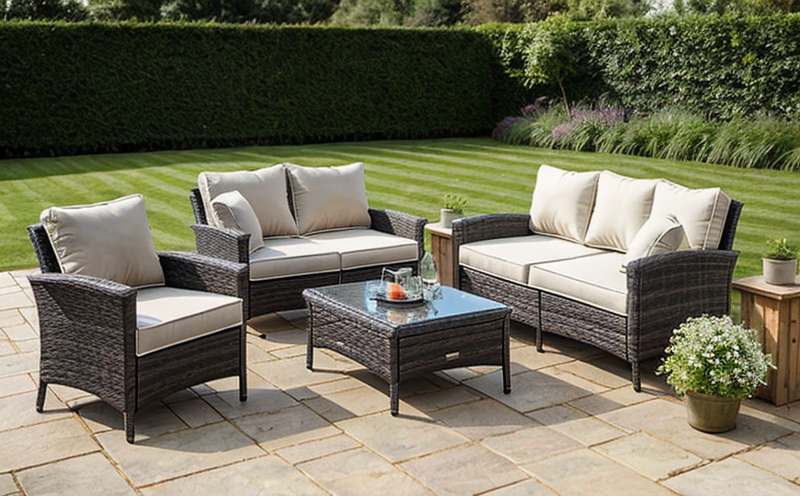DIN 4102 Fire Resistance Testing of Outdoor Furniture Upholstery
The DIN 4102 fire resistance test is a crucial procedure in the certification and quality assurance process for outdoor furniture upholstery. This testing ensures that fabrics used in outdoor settings, particularly those exposed to prolonged weathering and environmental factors, meet rigorous standards designed to enhance fire safety.
Outdoor furniture, especially when placed outside residential or commercial buildings, can be exposed to a variety of conditions that affect the durability and flame resistance of its upholstery. These conditions include direct sunlight, rain exposure, and potential contact with various flammable materials such as wood or plastic components. Therefore, ensuring that the upholstered material is fire-resistant helps prevent the spread of fire in case of accidental ignition.
The test involves subjecting a sample to controlled flame exposure under defined conditions specified by DIN 4102. The objective is to evaluate how well the upholstery resists igniting and spreading flames when exposed to an open flame source for a specific duration. This process not only guarantees that the fabric meets fire safety standards but also helps manufacturers ensure their products are safe for use in public spaces.
For outdoor furniture, compliance with DIN 4102 is essential because these items often serve as decorative elements or seating areas adjacent to buildings where fires can rapidly spread. Compliance ensures that even if a fire starts close by, the upholstery will not contribute significantly to its spread, thereby protecting lives and property.
The test procedure typically involves cutting a square piece of the upholstery fabric with dimensions ranging from 20 cm x 20 cm up to 35 cm x 35 cm. This sample is then placed on a metal holder that holds it vertically in a furnace where it is exposed to an open flame source for exactly five seconds. Afterward, the sample is removed and allowed to cool before being inspected for any signs of burning or melting.
The DIN 4102 standard provides detailed specifications regarding the type of flame source used (such as a gas burner), the temperature of the surrounding environment during testing, and the duration of exposure. These parameters are critical in ensuring that every test conducted adheres to international standards for consistency and reliability.
Manufacturers who comply with DIN 4102 demonstrate their commitment to producing high-quality, safe furniture products suitable for outdoor use. By meeting these stringent requirements, they also enhance consumer confidence by assuring them of the product's fire safety properties.
In addition to protecting end users from potential hazards, compliance with DIN 4102 supports broader sustainability goals by promoting the development and use of materials that are inherently safer in emergency situations. This approach aligns with growing global trends towards more sustainable practices across various industries.
Applied Standards
| Standard | Description |
|---|---|
| DIN 4102-1 | Method of Test for Fire Resistance of Upholstery Fabrics Used in Furniture |
| DIN 4102-2 | Fire Resistance of Upholstery Fabrics Used in Furniture - Part 2: Determination of Flame Spread |
| Test Parameters | Description |
|---|---|
| Flame Source | A gas burner with a nominal power output. |
| Sample Dimensions | 20 cm x 20 cm to 35 cm x 35 cm square pieces of upholstery fabric. |
| Environmental Conditions | Temperature controlled within ±1°C at the specified test conditions. |
Environmental and Sustainability Contributions
The DIN 4102 fire resistance testing contributes significantly to environmental protection by ensuring that outdoor furniture upholstery does not pose a risk of spreading fires during emergencies. By adhering to this standard, manufacturers can help mitigate the impact of accidental fires on both human life and property.
Moreover, compliance with DIN 4102 fosters sustainable practices within the industry by encouraging the development and use of materials that are inherently safer in terms of fire resistance. This approach supports broader sustainability efforts aimed at reducing environmental impacts associated with hazardous materials.
In addition to enhancing safety standards for outdoor furniture, meeting these requirements also promotes responsible sourcing of raw materials and manufacturing processes. Such practices contribute positively towards achieving long-term goals related to resource conservation and waste reduction.
By investing in DIN 4102 compliant testing solutions, companies demonstrate their dedication to producing safe and eco-friendly products that meet both regulatory requirements and market expectations regarding fire safety standards.
Competitive Advantage and Market Impact
- Enhanced reputation among consumers for providing safe and reliable outdoor furniture.
- Potential for higher sales due to increased customer trust in product quality.
- Better positioning within competitive markets as a leader in fire safety standards compliance.
- Achievement of certification marks indicating adherence to international norms, which can attract more customers globally.





